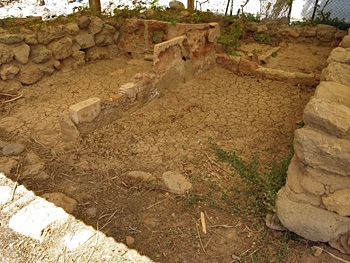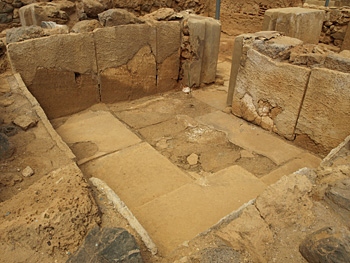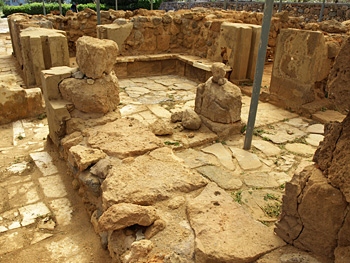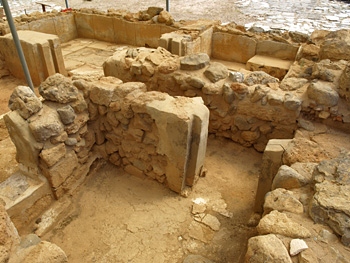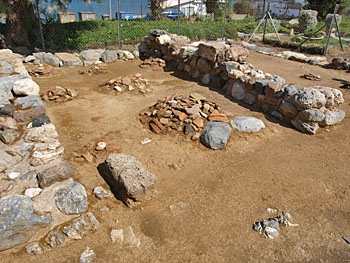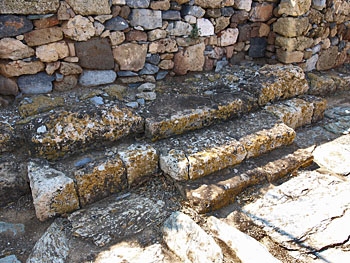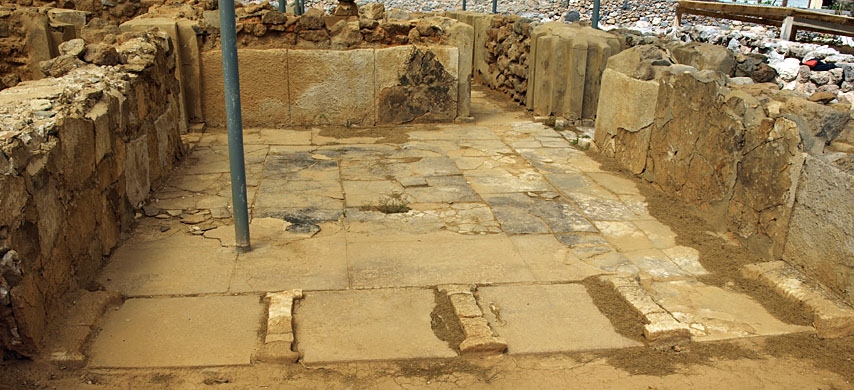
The excavation
Nirou Khani is situated next to the beach at Kokkini Khani, east of Heraklion, and just along the coast from the villa at Amnisos. The site was excavated by Xanthoudides in 1918-1919 and published in 1922. This two-storey building had 40 rooms on the ground floor. There were two courtyards, one to the east and one to the north of the building.
Nirou Chani contained two storage areas. The northern area was used for storing perishable goods in the corn bins and the adjacent pithoi rooms where wine and olive oil were kept. Non-perishable goods were stored to the south. These goods were mainly of a religious or ritual nature and included dozens of terra cotta tripod tables (also called altars), found in rooms 16-18, and four bronze double axes found in room 7. Other ritual objects found on the site include stone lamps and vases. Part of a fresco showing a "sacral knot" was found in corridor 11.
There was a paved court to the east of the building and at the south end of the court there is a set of several steps which some have interpreted as a "tripartite shrine". To the west of the "shrine", the remains of horns of consecration were found on a low wall.
The Minoan Hall
The Minoan Hall system, rooms 2 and 2a, form the main entrance to the "villa" from the east court. In the Minoan Hall system the main hall is divided into two areas of unequal size by a pier and door partition. (This is a row of double doors that can be opened into recesses in the wall). The smaller, outer area of the Minoan Hall is usually separated from the third area, a light well, by a portico.
At Nirou Chani the east court forms the "light well" and so the outer part of the Minoan Hall opened directly onto the East Court via a portico, while the inner area could be closed off by the doors in the pier-and-door partition. (See large top photo for the inner hall and at the bottom of the picture the remains of the pier-and-door partition).
From the main part of the Minoan Hall, entry to the rest of the building could be controlled through the three exits from the room, one to the south leading to the storage area where the altars and double axes were found, one to the north and the area of the perishable goods and a third exit leading west, further into the building where there was a room with built-in stone benches, a light well and stairs to the upper floor.
Two rooms with benches face each other across corridor 11. These are the benched hall (room 12) and room 15. Although the corridor appears to continue past these rooms, it seems that the corridor was blocked off just beyond these two entrances so anyone wishing to get further into the building or to access the staircase to the upper floor had to go through the benched hall, which effectively controlled access to these parts of the building. Room 15 has a paved floor and a bench along one wall. Its only entrance was from the corridor. It has been interpreted as a guardroom.
Room 12, on the other hand, has benches, faced with gypsum, along two walls. The floor was paved with ironstone in the centre of the room surrounded by a border of gypsum, a not uncommon feature of Minoan architecture. A pillar separated it from the light-well (room 13). Room 12 controlled access to the rooms with the altars (17 and 18) and the room with the oil lamps (14). Louise Hitchcock rejects the suggestion that the room was used for communal feasting on the grounds that it is too small and instead argues that it was possibly used by the people in charge of the "villa" to administer the building's activities and control access to the storerooms nearby.
Trading in cult objects?
The number of religious finds would have been more than enough for a much larger building so what exactly was Nirou Chani? Various interpretations have been offered. Evans and Xandoudides suggested it was a centre for making votive objects for export and possibly housed a major religious leader. Although it was also clearly a residence, some have argued that it was a semi-public building and this aspect cannot be written off given that it has an East Court. Indeed, Hitchcock argues that it may not have been a trading centre at all, but that the cult objects were actually used in ceremonies in the East Court of what was clearly an impressive building.
A more unconventional explanation of the site has been offered by Robert Koehl. He points out that one of the more important institutions in Crete of the historical period was the andreion, a place where the initiated males of each city took communal meals. Koehl believes that the andreion and the associated room where guests would sleep, called the koimeterion, were Minoan inventions, which went out of use during the Mycenaean period, only to be revived again in historical times. It is his contention that Nirou Chani was the site of one such andreion.
So could this have been an important rural religious centre? Or was it part of a larger settlement, with more buildings nearby? The discovery of a small Minoan harbour at Agii Theodhori is inconclusive as too much of the evidence has been destroyed.
Interestingly, a number of votive cups were found containing pieces of volcanic pumice from the Thera eruption. They had been placed underneath a shrine. It has been suggested that they may have been put there as a re-foundation or reconsecration deposit after the building had been repaired, assuming it had been damaged by a tidal wave in the first place.
Due to the economic depression gripping Greece the site is no longer staffed and is shut to the public but it can be seen quite well from the entrance. A short distance to the east, on the shore, the remains of the Minoan harbour can still be seen, in particular two basins cut out of rock, a long mole and traces of some other buildings.


